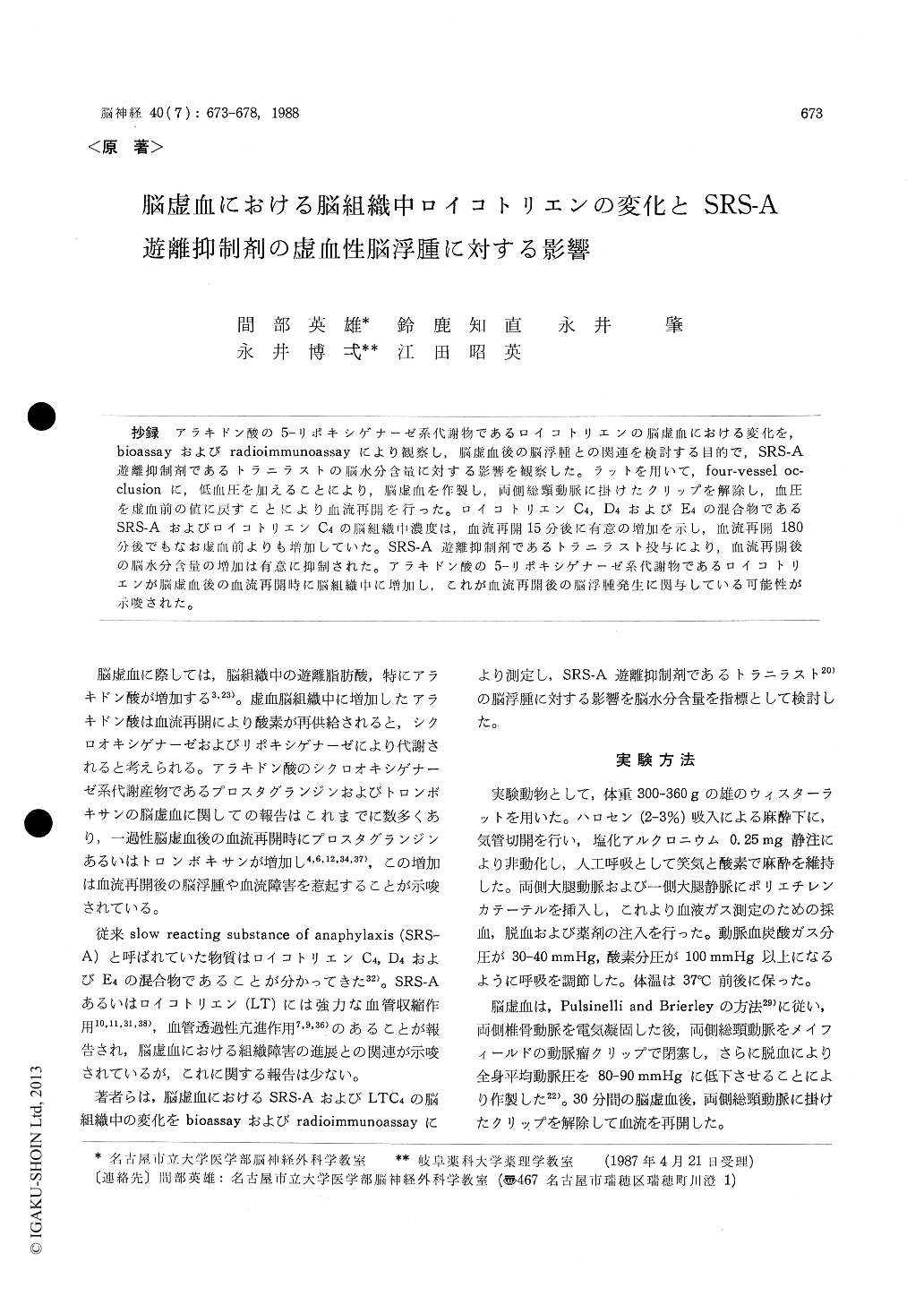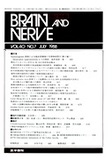Japanese
English
- 有料閲覧
- Abstract 文献概要
- 1ページ目 Look Inside
抄録 アラキドン酸の5-リポキシゲナーゼ系代謝物であるロイコトリエンの脳虚血における変化を,bioassayおよびradioimmunoassayにより観察し,脳虚血後の脳浮腫との関連を検討する目的で,SRS-A遊離抑制剤であるトラニラストの脳水分含量に対する影響を観察した。ラットを用いて,four-vessel oc-clusionに,低血圧を加えることにより,脳虚血を作製し,両側総頸動脈に掛けたクリップを解除し,血圧を虚血前の値に戻すことにより血流再開を行った。ロイコトリエンC4,D4およびE4の混合物であるSRS-AおよびロイコトリエンC4の脳組織中濃度は,血流再開15分後に有意の増加を示し,血流再開180分後でもなお虚血前よりも増加していた。SRS-A遊離抑制剤であるトラニラスト投与により,血流再開後の脳水分含量の増加は有意に抑制された。アラキドン酸の5-リポキシゲナーゼ系代謝物であるロイコトリエンが脳虚血後の血流再開時に脳組織中に増加し,これが血流再開後の脳浮腫発生に関与している可能性が示唆された。
Arachidonic acid metabolites are postulated to play a role in the pathogenesis of cerebral ische-mia.
In order to test the development of lipoxygenase metabolites of arachidonic acid in cerebral ische-mia, we measured free arachidonic acid and slow reacting substance of anaphylaxis (SRS-A) and leukotriene C4 in the brain tissue. Moreover, we studied the influence of inhibitor of SRS-A release on postischemic cerebral edema.
Severe forebrain ischemia in rats was induced bythe modification of the method described by Pulsi-nelli and Brierley. Both vertebral arteries were electrocauterized through the alar foramen and then bilateral common carotid arteries were clamp-ed by aneurysmal clips and mean arterial pressure was reduced to 80-90 mmHg. EEG activity was isoelectric throughout the period of carotid clamp-ing. After forebrain ischemia had been maintained for 30 minutes, recirculation was started by removal of the arterial clamps and by increasing blood pressure to the preischemic level.
Following the desired ischemic or postischemic periods, the brains were frozen in situ with liquid nitrogen. The brains were then chiselled out dur-ing irrigation with liquid nitrogen and stored at -80℃ until analysis. The brain extracts were analysed by high performance liquid chromatogra-phy for free arachidonic acid, by bioassay using the ileum of guinea pig for SRS-A and by radioim-munoassay for leukotriene C4. Brain water content was calculated with dry weight method. Inhibitor of SRS-A release, tranilast, was given intraperito-neally, 100 mg/kg 30 minutes before induction of ischemia and 50 mg/kg immediately before recircu-lation.
The arachidonic acid concentration increased strikingly during the ischemia and decreased rapidly after recirculation. The concentrations of SRS-A and leukotriene C4 increased significantly after recirculation and remained higher levels at 180 minutes after recirculation than the preischemic levels. Tranilast significantly reduced the in-creasing of postischemic brain water contents.
This study demonstrated that the increased ara-chidonic acid during ischemia in rat is metabolized to leukotrienes through the lipoxygenase pathway during subsequent recirculation. It is suggested that leukotrienes may play some role in the patho-genesis of postischemic cerebral edema.

Copyright © 1988, Igaku-Shoin Ltd. All rights reserved.


